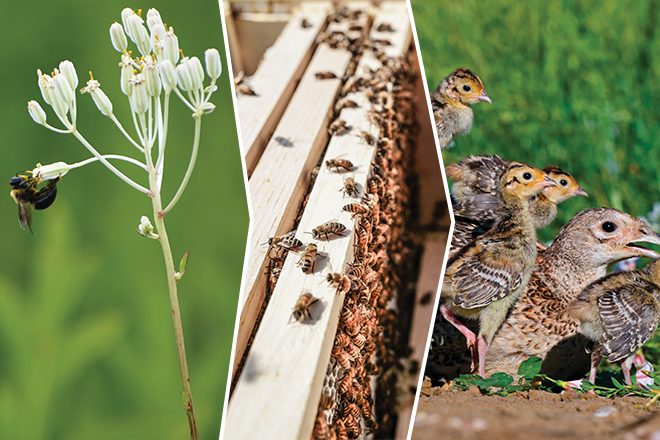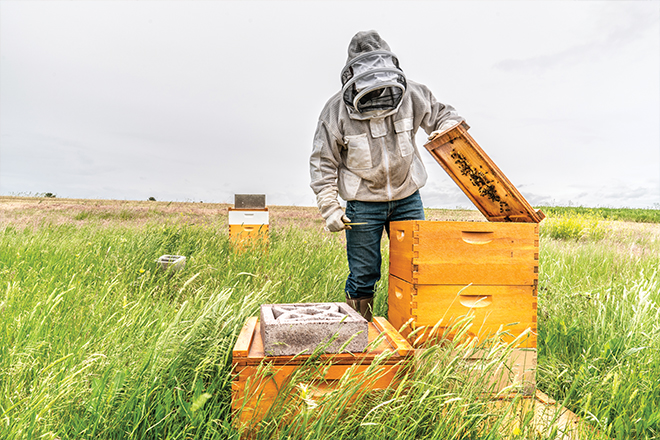A view of productive gamebird habitat from the perspective of a working honeybee
Story by Andrew McKeanLead photo by Alexis Bonogofsky
Every year around Halloween I come home to a box containing two gallons of unfiltered honey on my front porch. It’s no trick. It’s a treat from Jim Rodenberg and his crew at Northern Bloom Honey, a trade in exchange for allowing his hives to do their business on an unswathed corner of my alfalfa field.
As much as I relish the honey, which tastes like apricots, yellow raisins and curiously, straw — and, come February on the High Plains, is the equivalent of liquid sunshine — I most anticipate the note that accompanies this annual offering. In it, Rodenberg describes the honey season from the perspective of his Carniolan honeybees, detailing which flowers — clover, alfalfa or blue flax — contributed to the honey crop and how heat, drought and early or late frosts affected its production.
Nearly 20 years of these annual letters have opened a window into the world of bees and the pollen they require, but they’ve also allowed me to make an important comparison of my own. In the years that Rodenberg reports fulsome honey production, I have my best hunting seasons for pheasants and prairie grouse. For Rodenberg, whose family has been raising bees in Montana for a full century this year, the connection between the smallest and the largest winged creatures of my fields and surrounding uplands is clear.
“Pollinator habitat is the little black dress of conservation,” she says. “It can really go everywhere and it’s versatile enough to do anything.”
WINGED CONNECTIONS
“Birds and bees both need the same things, a mix of flowering plants and diversity of foods,” says Rodenberg, of Wolf Point, Montana. “They both need the right moisture at the right time. Any stand that attracts bees and butterflies will also have lots of other insects, and those insects are what young birds need when they’re coming up.”
The inverse is equally true. Monocultures of grain and even dreadlock stands of tired CRP grasslands don’t hold much interest for bees or crickets or weevils because flowers and the biotic complexity they bring are missing from the plant community. Pheasants and grouse might briefly visit these spots, but they spend vastly more time in adjacent habitats that are intricate, diverse and seasonally floral.
Those adjectives describe healthy pollinator habitat, says Leslie Cooper, a cooperative biologist for Pheasants Forever and Quail Forever.
“Pollinator habitat is the little black dress of conservation,” she says. “It can really go everywhere and it’s versatile enough to do anything.”
In her work in habitat restoration, Cooper observes — and often creates — abundant overlap between the seasonal succession of pollinator habitat, which generally includes a variety of native wildflowers, flowering shrubs and woody plants such as milkweeds and thistles, and the seasonal needs of upland gamebirds such as pheasants and bobwhite quail.
 Photos by Leslie Cooper (left), Alexis Bonogosfky (middle), Gary Kramer (right)
Photos by Leslie Cooper (left), Alexis Bonogosfky (middle), Gary Kramer (right)
“When we’re planting or improving a pollinator plot, we’re trying to mimic what historically occurred on the landscape, which is a high diversity of native forbs and wildflowers that bloomed in succession throughout the growing season,” says Cooper. “Pheasants and quail require nesting habitat, brood-rearing habitat and escape cover, and pollinator habitat is important to all three life-cycle components.”
She further notes that, unlike many stands of grass-centric Conservation Reserve Program (CRP) seedings, pollinator plots generally have plenty of bare dirt below the blooms.
“Young chicks need that open space at ground level when they’re the size of ping-pong balls, to move and to feed and to escape predators. It turns out that something like 70 percent of our native bees are solitary ground nesters, so it benefits them as well,” says Cooper.
“Later, as those chicks mature, they rely on soft-bodied insects for their protein, and pollinator habitat produces a massive amount of insect biomass,” Cooper continues. “And still later, after they transition to seeds, pollinator habitat continues to work for them because it contains a good diversity of seed-bearing plants.”
Pollinator habitat defined much of the country prior to industrial agriculture, when native bees and other insects handled pollination, and when periodic fire kept prairie stands fresh and prolific.
You’ve seen this pollinator habitat, even if you didn’t know it by name. It’s the tangled mess of sweet clover, fragrant coneflower and trouser-grabbing raspberry, buckbrush and snowberry, often near a blooming canopy of lilacs, chokecherry and wild plum. Often it occupies the wooly corner of a field or neglected old sidehill you don’t frequent because it’s so damned hard to walk through most seasons. But it’s precisely where you find late-season roosters or quail coveys when snow has drifted the fencelines. In addition to the other seasonal benefits of this complicated cover, it’s a quilted blanket in hard winters.
Not accidentally, it’s right were Rodenberg puts his hives on my land.
 Photo by Alexis Bonogosfky
Photo by Alexis Bonogosfky
DIVERSITY WINS
Honeybees are only one of many varieties of pollenating insects, which can include butterflies, moths, beetles, wasps and bumblebees. Within the honeybee family, ground-nesting natives have vastly different pollination habits from colony-dependent European honeybees like those raised by Rodenberg.
“I see the value in diversity, whether it’s in a wheat field or in an investment portfolio...”
But differences aside, they also have in common the ability to thrive in wild gardens, which is another pretty good description of pollinator habitat, whether in the central pheasant range or out on its edge in my eastern Montana.
On a bluff above the Yellowstone River east of Forsyth, Montana, Drew Steinberger hopes to convince his father, a fifth-generation dryland wheat farmer, to convert a few hundred acres of drought-prone stubble to a pollinator mix of some 16 different plants.
Steinberger anticipates that, by reducing input costs of fertilizer and herbicides, and by boosting the value of their land to upland birds, white-tailed deer and the Steinbergers’ sideliner bee business, conversion will pay off in a few years in hay, honey, and maybe a few Hungarian partridge and long-tailed roosters.
“I see the value in diversity, whether it’s in a wheat field or in an investment portfolio,” says Steinberger. “In either case, you’re trying to shelter yourself from the ebbs and flows of either Mother Nature or the stock market. With wheat, we’re struggling with high input costs and uncertain production due to drought and the markets. But with pollinator plantings, if it goes right, my dividend here is roosters, and a lot less money in chemicals.”
Working with conservation partner World Wildlife Fund, the Steinbergers can cost-share the expense of pricey pollinator seed mix. The payoff is a perennial stand of plants that might endure drought, hail and global commodity markets better than wheat has, all while making his family’s property more future-proof for changing customers and climates.
“It’s not lost on me that the beneficiaries are a couple of non-native species, European bees and Chinese pheasants,” says Steinberger, “but I think the intrinsic values are a lot deeper and broader than a stand of winter wheat that might make 40 bushels an acre in a good year and half that in a poor year.”
PATCHWORK POLLINATORS
Hundreds of miles to the west, Erin Fairbank fields questions similar to those that Steinberger is asking: How can pollinator patches supplement a working small-grain operation and add value to the larger landscape?
In what’s called Montana’s “Golden Triangle” of wheat production, Fairbank has found the answer in improving scraps of what she calls remnant cover. These are the overlooked borders of section-long grain fields, or the untidy corners of center-pivot irrigation systems, all of which are ideal candidates for small stands of pollinator cover.
“Over the years producers are seeing a connection between high levels of herbicide and pesticide use and declining insects and upland game birds,” says Fairbank, a Pheasants Forever partner biologist who works with Natural Resources Conservation Service (NRCS) partners. “A growing number of producers are recognizing that one way we can improve crops is to improve habitats for beneficial insects.”
It’s not inexpensive. Pollinator seed mixes cost anywhere from $70 to $300 an acre, plus the costs to prep the ground and plant the seed. Fairbank negotiates cost-share agreements with local NRCS cooperators to enable producers to afford converting remnant cover to pollinator plots. The result has been less wind erosion, better insect diversity, and a flush of pheasant and grouse production in an area that’s seen a long-term decline in upland birds.
Click image to view larger.
BLOOMS > BEES > BIRDS
Back on Montana’s Hi-Line, beekeeper Jim Rodenberg observes what he calls a “happy bee” metric that helps him assess honey production.
When bees don’t have to travel far from their hive to collect pollen, and when the landscape is a garden of cultivated and wildflowers, he has bumper crops of what he calls his “liquid gold.” But Rodenberg is also a bird hunter, and he has his best days on wild roosters in those fields where his bees thrive.
“It’s the bloom,” says Rodenberg. “The bees are looking for it. The insects like it. And the birds follow because it provides everything they need. If you take care of the bloom, then everything else sort of takes care of itself.”
Andrew McKean writes, watches the wildflowers bloom and consumes fine honey from his home in eastern Montana.
This story originally appeared in the 2022 Summer Issue of the Pheasants Forever Journal
. If you enjoyed it and would like to be the first to read more great upland content like this, become a Pheasants Forever member today!